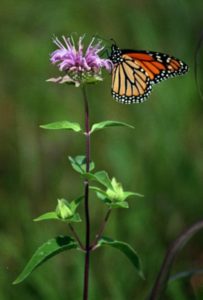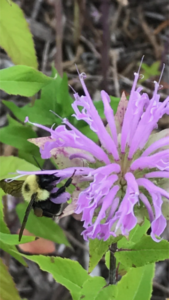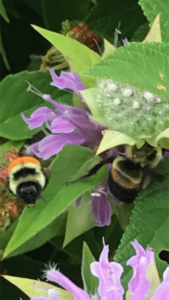The Forest Service yard is starting to work. Pictured are pictures of bees pollinating by our Bee Balm.
Please see the Star Tribune Article on Bee Balm!
!


BEE BALM
Monarda
Bee balm is a must for summer gardens because it provides a month or more of colorful blooms. Several monarda species — including red-flowered M. didyma and lavender-flowered M. fistulosa — are native perennials in Minnesota. They, and the many hybrid cultivars of bee balm, are easy to grow and winter-hardy through Zone 4.
From midsummer to early autumn, bee balm displays a profusion of crownlike flowers in eye-catching shades of red, pink and purple. Bees and hungry hummingbirds are drawn to the tubular florets for sips of nectar — another great reason to include this flower in your garden. And, for a touch of scent, its straight, square stems sport pairs of lance-shaped, dark green leaves that emit a delicious citruslike aroma when you brush against them.
A site in full sun is best, but bee balm will also grow in partial shade. Most bee balms prefer loamy soil with even moisture levels, though M. fistulosawill tolerate drier conditions. Soil should be fairly well-draining because overly soggy soil in the winter can lead to root rot.
Divide bee balm when it spreads too far or dies out in the middle. Bee balm’s one major flaw is its susceptibility to powdery mildew. Fortunately, that can be minimized in the garden by selecting resistant cultivars, spacing and thinning plants to allow good air circulation and avoiding drought stress.
Bee balm combines beautifully with other perennials, ornamental grasses and even annual flowers. If you want to go all native, grow bee balm with other prairie plants such as butterfly weed, sky-blue aster, showy goldenrod and Indian grass.
NANCY ROSE
Plant type: Herbaceous perennial.
Hardiness: Zone 3 or 4.
Size: Most are 3 to 4 feet tall, but some cultivars stay as small as 12 inches tall.
Available as: Species can be grown from seed. Cultivars are available as container plants.
Fun fact: Bee balm’s fragrant foliage may remind you of Earl Grey tea. That’s because the traditional English tea is flavored with bergamot oil, which is extracted from bergamot, an Italian citrus fruit. Early plant explorers thought monarda foliage smelled like the fruit and gave the plant one of its common names: wild bergamot.





